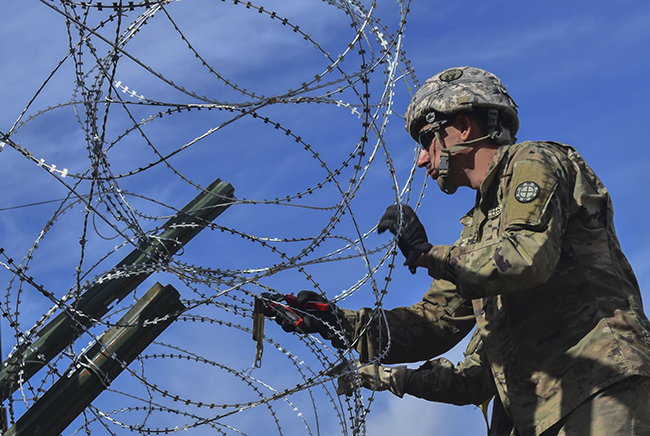
An engineer soldier hangs concertina wire along the southwest border in Nogales, Ariz., Jan. 16, 2019. DOD photo by Army Sgt. Nicholas Brown-Bell.
House Armed Services Committee Ranking Member Rep. Mac Thornberry (R-Texas) on Wednesday suggested the Defense Department should consider hiring contractors for tasks at America’s southern border instead of relying on military personnel.
Thornberry believes the Pentagon should consider contractor availability when processing the Department of Homeland Security’s requests for help addressing the flow of migrants across the border. Just because DOD can do it doesn’t mean the military is best suited for the work, he said.
“Contractors run sensors all over the world and the other logistical support,” Thornberry said. “I think that’s maybe a better way forward than to continue to expand the job of our military.”
The Department of Homeland Security and US Customs and Border Protection do employ contractors, but they aren’t always available where work needs to be done, said Kenneth Rapuano, the Pentagon’s assistant secretary of defense for homeland defense and global security. It also takes time to get the workers under contract and started on projects.
“There are certain functions that are DOD military capabilities: sensors, the barrier construction in terms of the concertina wire, for which we do have ready capabilities,” Rapuano said. “In terms of the logistics management for migrant processing, that is not necessarily a lead military skill, but it certainly is a capability that we can provide in exigent circumstances.”
Thornberry’s suggestion comes two days after Pentagon spokesman Army Lt. Col. Jamie Davis announced about 320 Defense Department personnel will be tasked with several new jobs in support of DHS through Sept. 30, at a cost of $7.4 million. Thousands of troops are already deployed to the border.
“DOD personnel will assist in driving high-capacity CBP vehicles to transport migrants; providing administrative support, including providing heating, meal distribution and monitoring the welfare of individuals in CBP custody; and attorney support to ICE,” Davis said in an statement Monday. “In any situation that requires DOD personnel to be in proximity to migrants, DHS law enforcement personnel will be present to conduct all custodial and law enforcement functions, and provide force protection of military personnel.”
DOD workers will not act as law enforcement, he added.
“When we’ve gone through and looked at the conditions at the border and … CBP’s ability to actually perform their duty, they’re thousands of people short,” Acting Defense Secretary Patrick Shanahan said at a House Appropriations defense subcommittee hearing the same day. “We’re driving buses. We’re serving food. We’re doing medical support.”
While DOD leaders were addressing the issue on Capitol Hill, the Associated Press also reported the Trump administration asked Congress Wednesday for an additional $4.5 billion in emergency funds to address urgent humanitarian needs at the US-Mexico border.
The Defense Department has identified a pot of about $4.3 billion that could be used to fill the $3.6 billion hole the Trump administration says it needs for a wall along the border, Pentagon Assistant Secretary of Defense for Sustainment Robert McMahon told HASC’s readiness subcommittee. The final list of military construction projects whose funding could be redirected to pay for a border wall is expected to be finished May 10.
DOD will not include projects to be awarded in fiscal 2019 or those focused on housing, barracks, and dormitories in the list.
“Where we are today is that list from each of the services is being collected at the OSD comptroller level,” McMahon said Wednesday. “That difference between what we need and what’s available [is] about $700 million.”
He added the $4.3 billion pot is a skinny version of the $12.9 billion list of unobligated MILCON projects that could be tapped to pay for a border barrier. The Pentagon sent lawmakers that list in March.
